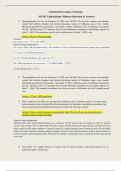Chamberlain College of Nursing
NR 503 Epidemiology Midterm Questions & Answers
1. The population of a city on February 15, 2005, was 36,600. The city has a passive surveillance
system that collects hospital and private physician reports of influenza cases every month.
During the period between January 1 and April 1, 2005, 2,200 new cases of influenza occurred in
the city. Of these cases, 775 persons were ill with influenza according to surveillance reports on
April 1, 2005. The prevalence rate of active influenza as of April 1, 2005, was:
Answer: 20 per 1,000 population
Answer:
prevalence rate = 21.17 per 1000
Step-by-Step explanation
At a given time, the prevalence rate = the number of cases of disease/ that cases present in a population
775 cases for 36,600 population
so, for 36,600 population, the cases are 775
for 1000 population the cases are = 775x1000/36600 = 21.17
so, prevalence rate = 21.17
2. The population of a city on February 15, 2005, was 36,600. The city has a passive surveillance
system that collects hospital and private physician reports of influenza cases every month.
During the period between January 1 and April 1, 2005, 2,200 new cases of influenza occurred in
the city. Of these cases, 775 persons were ill with influenza according to surveillance reports on
April 1, 2005. The monthly incidence rate of active cases of influenza for the 3-month period
was:
Answer: 20 per 1,000 population
3. What would be the effect on age-specific incidence rates of uterine cancer if women with
hysterectomies were excluded from the denominator of incidence calculations assuming that
most women who have had hysterectomies are older than 50 years of age?
Answer: Rates would increase in women older than 50 years of age but may decrease in
younger women as they get older.
Step-by-Step explanation
Women who have had hysterectomies (i.e., removal of the uterus) are no longer at risk for uterine
cancer. For women who is older than 50 years of age, would increase the age-specific incidence rate as
there would be the same number of uterine cancers a curing among fewer women at risk. On the other
hand, rates may decrease among younger women who have had hysterectomies as they are no longer at
risk for uterine cancer and thus may decrease the number of potential cases occurring in their age group
over time.
4. The ability of a single person to remain free of clinical illness following exposure to an
infectious agent is known as:
, Answer: Immunity
Step-by-Step explanation
If someone remains free of some illness following exposure to an infectious agent then we say the
person has a strong immune system therefore the ability is referred to as immunity
5. Which of the following reasons can explain why a person who did not consume the infective
food item got sick?
Answer: All of the above
Though it may seem surprising, getting a case of food poisoning from a person instead of food isn't all
that unusual. People get sick when bacteria, such as salmonella and E. coli, contaminate the food they
eat.
This can happen in a variety of ways. Bacteria live in the intestines of cattle, chickens, and other
animals raised for food. If feces come into contact with the meat during slaughter, that meat can carry
the bacteria. For plant foods, the source is typically animal waste from the field (such as in the form of
manure) or tainted water. The bacteria can also be spread through cross-contamination in the
processing plant or in a home or restaurant kitchen.
Foodborne illnesses can be caused by any of:
Contaminants
Improper food handling practices
Food allergies
Understanding each of these is critical in ensuring that food safety is maintained. [1]
Food contaminants can be:
Chemical, such as cleaning agents or pesticides
Physical, such as hair, bandages, or glass
Biological, such as pathogens and microbes introduced from infected workers, unsanitary work
surfaces, or contaminated water
6. Which of the food items (or combination of items) is most likely to be the infective item(s)?
Answer: Ice cream only
Ice cream protects microorganisms from destruction, even during heat treatment by pasteurization used
in the production process. Therefore, the presence of potentially pathogenic bacteria in it is not rare.
Besides this, during the processing after the pasteurization step, there is a potential hazard by the
addition of contaminated ingredients or improper handling of the final product.
Occurrence of Bacillus cereus, Salmonella, Listeria, and Yersinia in ice cream has been reported. The
fact that these pathogens can survive in food, even at low temperatures as in ice cream, makes them of
particular importance as they may cause food borne diseases to the consumers of infected ice cream
and suggests that commercially produced ice cream still occasionally may be a potential cause of food
borne diseases.
There have been reports of outbreaks of food borne diseases by the consumption of ice cream. One of
the most serious outbreaks, the largest ever recognized in the United States, was a national outbreak
of Salmonella enteritidis infection due to the consumption of ice cream made by a large national
producer. The Minnesota Department of Health estimated that S. enteritidis gastroenteritis developed in
224 000 persons, and this outbreak of salmonellosis was the result of contamination of pasteurized ice
cream premix during transport in tanker trailers that previously had carried non pasteurized liquid eggs.




